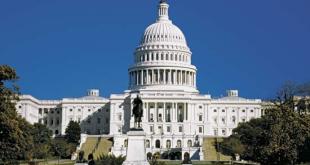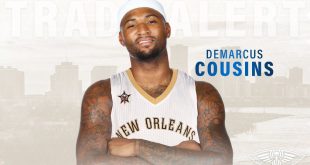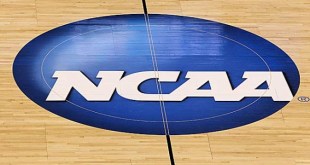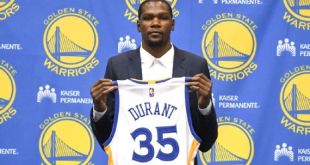“It is our belief that we have a better chance to grow the (financial) pie that gets divided 50-50 if we increase the age and create, in essence a more competitive league.” -NBA Commissioner Adam Silver[i]
The rules for eligibility for the NBA draft are laid out in the current collective bargaining agreement.
“A player shall be eligible for selection in the first NBA Draft with respect to which he has satisfied all applicable requirements….below….The player (A) is or will be at least 19 years of age during the calendar year in which the Draft is held, and (B) with respect to a player who is not an international player …at least one (1) NBA season has elapsed since the player’s graduation from high school (or if the player did not graduate from high school, since the graduation of the class with which the player would have graduated had he graduated from high school.”
Commissioner Silver’s comments in February did not articulate a new idea or a change in direction among the NBA owners. The idea can be traced back at least as far as 2009 under Commissioner David Stern.[ii] Whether or not this is a good idea, or what the ideal situation is depends on who you ask and when. However, in order to discuss or construct ideal draft eligibility requirements requires an understanding of the relevant law, past challenges to such requirements and the structures other sports have used.
Relevant Law and High Profile Legal Challenges
Section 1 of the Sherman Act makes illegal any contract or agreement “in restraint of trade.” This covers everything from price fixing, to illegal ties, to even in some cases the dreaded “Vertical Integration.” Generally speaking the Sherman Act serves to protect consumers and competition. However, it can also apply to restraints in the market for labor, which would include an age restriction. In Mackey v. National Football League, the 8th Circuit Court of Appeals held that, “restraints on competition within the market for players’ services fall within the ambit of the Sherman Act.” So if restraints on the labor market are illegal, how does such an age restriction exist for the NBA?
Those familiar with antitrust law will be quick to point out that the non-statutory labor exemption exempts from the purview of the Sherman act, any agreement that is the result of good faith, arms length collective bargaining between a union and an employer. However, while draft age restrictions are collectively bargained, those people which are affected by the restrictions are not members of the union. Courts have addressed this issue in the past. In Wood v National Basketball Association, the Second Circuit noted that it was common for a collective bargaining agreement to affect workers outside the bargaining unit. Additionally, in a high profile case related to Ohio State running back sensation, Maurice Clarett, the Southern District of New York held “[t]here is no dispute that collective bargaining agreements, and therefore the nonstatutory labor exemption, apply to both prospective and current employees.” Thus, while not a settled issue, it would appear that prospective NBA players have little chance to win a right to play in the NBA in the courtroom and will continue to be at the mercy of the NBA and the union.
Motivations for Increasing the Age Limit and Skepticism
The idea of increasing the age limit has been meet with optimism and skepticism from former players, media personalities and even casual fans.[iii] From an economic point of view, current NBA players should be in favor of an increased age limit. The NBA has a set number of roster spots and a set amount of money to spend on players across the league. By increasing the draft age limit, the NBA is effectively decreasing the pool of eligible players each year, meaning there are fewer rookies to take roster spots and dollars away from veteran players. Commissioner Silver echoed this sentiment, “I never quite understood the player opposition. Of course it’s a zero sum game in terms of numbers of jobs, and amount of salary we pay out. We pay out roughly 50% of BRI (basketball-related income), and that’s divided among the players in the league. So there is absolutely, and by definition can’t be, a financial savings to us by increasing the age to 20.”[iv]
The Commissioner’s stated reasons for wanting to increase the age limit include giving NBA teams an extra year to scout players, which would presumably decrease so called draft “busts,” and to give younger players more of an opportunity to “lead,” which seems to be a trait valued by NBA team personnel.[v] Commissioner Silver smartly stayed away from the paternalistic “maturity” arguments or any statistical arguments on the success rate of one and done or high school players versus upperclassmen. The fact of the matter is the sample of one and done or high school players is still small compared to what would be needed for a statistically significant sample size and there are success stories and failures among players of all ages at the time of the draft.
The Ideal Structure
The question of what the ideal system for the NBA draft age limit has a different answer for every person you ask the question of. However, some insight may be gained from analyzing other professional sports draft restrictions. Odds are the best idea is your standard draft age restriction, but maybe it’s something really cool we don’t even know about.
The NFL system is probably of the least use to the NBA. The NFL requires players to be three years removed from high school to be eligible regardless of actual age (see Amobi Akoye). However, the NFL has much better reasons for a larger restriction given the physical aspects of the game. In almost all cases an 18 year old NFL player would end up like this.
Major League Baseball allows players to be drafted out of high school. However, if a player attends a four year university he must stay at least three years before he is eligible for the draft again after his junior or senior season. Players who attend junior college or any non-four-year university are eligible each draft after they graduate high school. This system is seen by many as a middle ground between the NBA’s proposed 20 year old age restriction and a free market. It allows the best talent to become a professional immediately, while providing MLB teams with three years of college ball to scout. A system like this is probably what is best for the NBA. Whether or not it is best for the players is another question.collective-bargaining-agreement-2011-2020
The NHL, similar to MLB allows prospective players of ages 18 to 20.5 to declare for the draft, with upperclassmen usually being free agents and thus providing a higher degree of flexibility.
Professional soccer in Europe has no draft at all and players come up through academies, and are eligible to play at age 15. I won’t touch the Pandora’s Box of proposing the NBA draft be eliminated and the training responsibility be given to the AAU system.
Closing Thoughts
So what is the “best” system? As stated above, something similar to the MLB or the NHL probably strikes the best compromise between the interest of the NBA and the interests of potential players. The arguments for increasing the draft age range from well reasoned (provide NBA teams with more time to scout players thus giving teams more information about prospective players) to the ever paternalistic “maturity” arguments which seem to hold little water. LeBron James and Derrick Rose are doing just fine. Players who attend college don’t always mature either (for example when scouts told former UCONN draft prospect to work on getting more “steals” I don’t think this is what they meant).
Another consideration in basketball is that basketball has options for 18 and 19 year olds who don’t want to play NCAA basketball that other sports simply do not have. Such players can go play abroad (See Brandon Jennings or Jeremy Tyler) or to the NBA Developmental League (from which you can be drafted) (See PJ Hairston). Thus, an age restriction for the NBA draft is arguably less damaging than in football where players are essentially forced to go to college.
From a practical level there are challenges in raising the age requirement as well. As noted above, though exempted from the purview of antitrust law, an age restriction must be collectively bargained. Making this a challenge is the fact that the NBA Players Association does not have a director. Chris Paul is the player leader and Kevin Johnson has been consulting but since Billy Hunter left the NBPA in a steaming pile of wreckage, the organization has been drifting in a leadership void.
The NBA will in all likelihood eventually raise the age limit to 20 years old. As stated above, the NBA owners want this, and it isn’t harmful to the players the NBPA represents (in fact it is economically beneficial). In the meantime, we can all get back to doing what we do best, enjoying Jay Bilas troll NBA draft watchers playing the “wingspan” drinking game, and watching ESPN trot out Fran Fraschilla in his annual appearance to pronounce the names of every foreign prospect.
[i] http://www.usatoday.com/story/sports/nba/2014/02/13/adam-silver-commissioner-qa-age-limit/5458701/ [ii] http://sports.yahoo.com/blogs/nba-ball-dont-lie/adam-silver-wants-to-raise-the-nba-s-draft-age-minimum-to-20-to-make-the-league-and-the-draft-more-competitive-214448718.html [iii] for a discussion of comments of both sides of the issue see, http://sports.yahoo.com/blogs/nba-ball-dont-lie/several-clippers-including-union-president-chris-paul-oppose-commissioner-adam-silver-s-plan-to-raise-draft-age-minimum-213826042.html [iv] http://www.usatoday.com/story/sports/nba/2014/02/13/adam-silver-commissioner-qa-age-limit/5458701/ [v] http://www.usatoday.com/story/sports/nba/2014/02/13/adam-silver-commissioner-qa-age-limit/5458701/
 The Sports Esquires Putting Sports on Trial
The Sports Esquires Putting Sports on Trial




